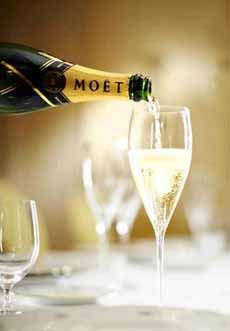PRODUCT: Red, White & Blue Champagne
|
Chandon, Moet et Chandon’s sparkling wine from Napa Valley, has been issuing a limited-edition red, white and blue bottle of its brut sparkling wine for the past six years; a different design each year.
Founded in 1973 by venerable French champagne house Moët & Chandon, Chandon was the first American sparkling wine venture established by a French Champagne house in Napa Valley. Its Napa Valley vineyard holdings, Chandon grows the traditional French champagne grapes: chardonnay, pinot noir and pinot meunier. They also create limited-edition bottles for New Year’s Eve; but let’s get back to the red, white and blue. The bottles of Chandon Brut in American flag colors bottle was so popular, that three years ago the winery launched a companion bottle of Chandon Rosé. If you’re pouring bubbly over Memorial Day and Independence Day weekends, these peak-chic bottles are the ones to pour. It’s the same delicious Chandon Brut and Rosé, in standard sizes and minis—the latter a festive party favor. The bottles, officially called the American Summer Limited Edition, are available Memorial Day through Labor Day at select retailers. If your wine and liquor store doesn’t carry them, they can order them for you by the case. You can purchase them at Chandon.com as well. Whether from Champagne or another region of the world that produces sparkling wines*, sparkling rosé champagne is typically more expensive than sparkling white wine. That’s because making it is more labor-intensive and time-consuming. There are two ways to make rosé champagne. We’ll start off with the fact that there are two main wine grapes grown in the Champagne region: chardonnay (white grapes) and pinot noir (black grapes†). Champagne can be made from: Making a rosé takes extra steps. The most common method in the Champagne region is to blend still red wine into the champagne. The red wine produces deeper, more robust red fruit aromas. The other approach, used by the top houses, is more complicated and more costly. During the part of the juice fermentation called maceration, the winemaker allows skin contact of the red grape skins, with the pressed white juice. |

|
|
|
The process is very carefully monitored to extract the color, tannin and flavor compounds from the skin. It produces a more delicate flavor than blending in red wine. (Champagne trivia: The coveted pale salmon color known as oeil-de-perdrix, partridge eye, which dates to the Middle Ages in Champagne. It gave its name to a style of rosé wine made in Switzerland. Here’s more information.) Champagne houses pride themselves a consistent house style. The challenge with either approach to making rosé champagne is to create the same color year after year, even though the blend of grapes changes based on the harvest (i.e., the sweetness and other properties of the harvested grapes). But…back to summer sipping: A sparkling wine lighter than champagne is best in the outdoor heat. Here are the different types of sparkling wine and sparkling rosé. ________________ †Red wine grapes are referred to as black in the industry. Depending on varietal, they can range from dark red to purplish black in color. ‡By law, arbane, petit meslier, pinot blanc and pinot gris can also be used in the blend. Some producers use them to round out the flavors; but these grapes comprise just a fraction of the the grapes grown in the region. |
||




